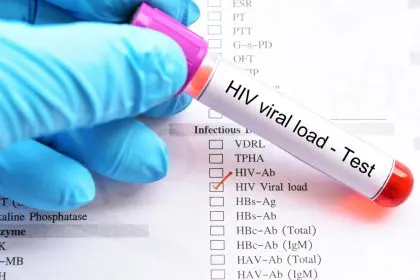You squint. You hold it up to the light. You take it to the window, then back to the bathroom. You snap a photo and enhance the brightness. Is that really a line? Or just your desperate hope materializing as an imaginary shadow? The faint line on a pregnancy test creates a special kind of limbo that can feel like emotional torture.
In a world of instant clarity, pregnancy tests remain stubbornly analog in their ambiguity. That whisper of a line could mean several things, and none of them offer the black-and-white answer you’re craving right now. Let’s decode what that faint line might be telling you and what steps can help you find certainty.
What that ghostly line actually means
Home pregnancy tests work by detecting human chorionic gonadotropin, commonly known as hCG, in your urine. This hormone starts appearing shortly after a fertilized egg implants in the uterine lining, usually about 6-12 days after conception. As pregnancy progresses, hCG levels typically double every 48-72 hours in early pregnancy.
A faint line generally indicates one of several possibilities, each with different implications for your pregnancy journey.
First, you might be testing very early. Those barely-there lines often appear when hCG is just beginning to show up in your system. The technical term for this is a “chemical pregnancy,” which simply means a pregnancy detected by chemical means before it would be visible on ultrasound. Many women test so early now that they’re detecting pregnancies that previous generations would never have known about before ultrasound.
Second, your hCG levels might be naturally low or rising more slowly. While the textbooks give average doubling times, actual hormone patterns vary significantly between women and between pregnancies. Some perfectly healthy pregnancies start with lower hCG levels that rise more gradually.
Third, you might be experiencing a pregnancy that isn’t progressing normally. Sometimes hCG rises initially but then plateaus or falls, indicating the pregnancy may not continue developing. This could eventually result in a miscarriage, though not all low or slow-rising hCG levels lead to pregnancy loss.
Finally, there’s the possibility of an evaporation line or test malfunction. These aren’t actual positive results but artifacts of the testing process. Evaporation lines typically appear after the test’s time limit has passed and often lack the color of a true positive.
The numbers game everyone obsesses over
If you’ve gotten a faint positive and contacted your healthcare provider, they might order blood tests to measure your exact hCG level. This quantitative testing provides more precise information than the qualitative yes/no of home tests.
But these numbers often create a new source of anxiety as women compare their levels to charts and averages found online. The truth is that normal hCG levels vary enormously between individuals. At 4 weeks from your last menstrual period, levels can range from 5 to 426 mIU/mL and still result in healthy pregnancies.
What matters more than the absolute number is the pattern of increase. In viable early pregnancies, hCG typically doubles every 48-72 hours. But even this isn’t absolute. About 15% of normal pregnancies don’t follow this pattern yet still result in healthy babies.
When blood tests show borderline or low hCG, doctors usually recommend serial testing, checking levels every two to three days to observe the trend. This waiting period can feel excruciating but provides the most accurate information about your pregnancy’s development.
The waiting game that tests your sanity
Perhaps the most challenging aspect of a faint positive or borderline hCG result is the unavoidable waiting period that follows. Unlike many other medical questions that can be resolved with a single definitive test, early pregnancy exists in a state of becoming. Only time will reveal which path this potential pregnancy will take.
During this limbo, many women find themselves engaged in behaviors they know are probably counterproductive. Testing multiple times a day looking for darker lines. Analyzing symptoms or lack thereof with detective-like scrutiny. Googling countless variations of “faint line success stories” or “low hCG viable pregnancy.”
While completely understandable, these behaviors usually increase anxiety without providing actual answers. The test can’t get darker in a matter of hours. Symptoms fluctuate naturally throughout the day. And internet anecdotes, while temporarily comforting or concerning, cannot predict your individual outcome.
For many women, finding ways to manage this waiting period becomes crucial for mental wellbeing. Setting boundaries around testing, such as allowing yourself one test every other morning with first morning urine, can provide structure without fueling obsession. Limiting time in online forums where the collective anxiety can amplify your own fears also helps many navigate this uncertain time.
When to worry and when to wait
Not all concerning signs require immediate panic, but some situations do warrant prompt medical attention during this uncertain period.
Severe, persistent pain localized to one side of your lower abdomen, especially if accompanied by shoulder pain or dizziness, requires emergency evaluation. These symptoms can indicate an ectopic pregnancy, where the embryo implants outside the uterus, usually in a fallopian tube. Ectopic pregnancies are medical emergencies that can’t continue and may threaten the mother’s life if not treated promptly.
Heavy bleeding comparable to a period generally merits same-day medical contact, though light spotting or brown discharge often occurs in normal early pregnancies. About 25-30% of women experience some bleeding in early pregnancy, and many go on to have healthy pregnancies.
Dramatically worsening symptoms like nausea or dizziness, especially if they interfere with your ability to stay hydrated or function, also deserve medical evaluation. While morning sickness is common, severe symptoms might indicate hyperemesis gravidarum or other complications requiring treatment.
In the absence of these concerning symptoms, the wisest course usually involves patience, scheduled follow-up with your healthcare provider, and gentle self-care during a naturally stressful time.
Self-care strategies while in limbo
The emotional toll of pregnancy uncertainty can be immense, especially for those who have experienced previous losses or undergone fertility treatments. Acknowledging this stress as valid rather than trying to “just think positive” honors your emotional reality.
Finding ways to be present rather than projecting into an uncertain future helps many women navigate this waiting period. Simple mindfulness practices like focusing on your breath for a few minutes, noticing physical sensations without judgment, or engaging fully in an absorbing activity can provide brief respites from the whirlwind of what-ifs.
Physical self-care during this time includes the standard early pregnancy recommendations. Continue taking prenatal vitamins, avoid alcohol and smoking, stay hydrated, and get adequate rest. These actions benefit your health regardless of the pregnancy outcome and give you the comfort of knowing you’re doing everything within your control.
When the answer finally comes
Eventually, the limbo of uncertainty resolves. The line darkens clearly over days, an ultrasound reveals a developing embryo with a heartbeat, or alternatively, bleeding begins and hCG levels fall, indicating the pregnancy isn’t continuing.
Each outcome carries its own emotional landscape. A confirmed viable pregnancy brings joy often tempered by the anxiety that followed you through the uncertain period. A pregnancy loss brings grief that others might not fully understand, especially if they never knew you were pregnant in the first place.
Either way, the experience of living through the uncertainty of a faint line or borderline hCG often changes something in your perspective. Many women report a new awareness of just how common these ambiguous beginnings are, despite how little they’re discussed in typical pregnancy narratives that jump from clear positive test to confirmed ultrasound.
If you’re in this limbo right now, know that you’re not alone in feeling overwhelmed by the uncertainty. Countless women have stood exactly where you stand, squinting at faint lines and waiting for clarity. Whatever outcome awaits you, your feelings during this time are valid, and this experience of uncertainty is a real and significant part of many women’s reproductive journeys.
















